Impact of Macro and Micro Environment on Sainsbury
VerifiedAdded on 2023/01/13
|21
|5615
|83
AI Summary
This report discusses the impact of macro and micro environment on Sainsbury, including PESTEL analysis, SWOT analysis, and Porter's five forces.
Contribute Materials
Your contribution can guide someone’s learning journey. Share your
documents today.
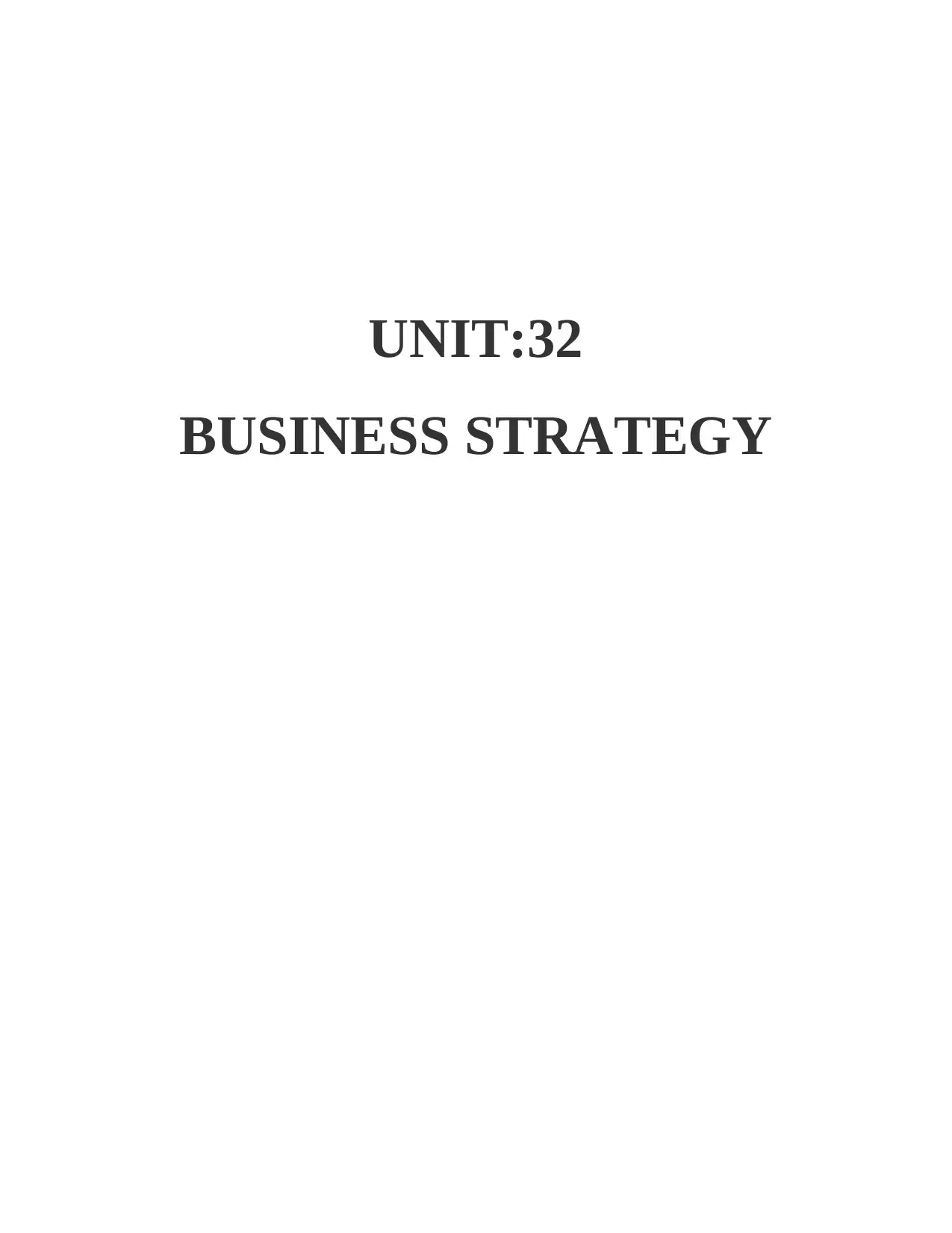
UNIT:32
BUSINESS STRATEGY
BUSINESS STRATEGY
Secure Best Marks with AI Grader
Need help grading? Try our AI Grader for instant feedback on your assignments.

TABLE OF CONTENTS
INTRODUCTION...........................................................................................................................3
MAIN BODY ..................................................................................................................................3
Impact of macro environment on organization......................................................................3
Impact of micro environment on organization.......................................................................7
Porter five forces....................................................................................................................9
Strategic management plan...................................................................................................12
Increasing quality of products as well as services................................................................14
CONCLUSION..............................................................................................................................17
REFERENCES..............................................................................................................................18
INTRODUCTION...........................................................................................................................3
MAIN BODY ..................................................................................................................................3
Impact of macro environment on organization......................................................................3
Impact of micro environment on organization.......................................................................7
Porter five forces....................................................................................................................9
Strategic management plan...................................................................................................12
Increasing quality of products as well as services................................................................14
CONCLUSION..............................................................................................................................17
REFERENCES..............................................................................................................................18

INTRODUCTION
Business strategy is predominately the mixture of all decisions which are been taken by
organizations as well as actions and activities performed by them for accomplishing long as well
as short term goals. Sainsbury is primarily the renowned supermarket chain and retail
organization, being established in 1869 by John James. Sainsbury and headquartered in London,
UK.
This report gives a brief about impact of macro environment on organization, impact of
micro environment on organization, Porter five forces and strategic management plan.
MAIN BODY
Impact of macro environment on organization
Micro environment is basically the business environment which consist of various factors
as well as components that exists within the organization and hence impacts the overall
performance of organization. Macro environment on the other hand, are external factors which
influences the functioning of organizations externally and thus affects their decision making.
PESTEL analysis
PESTEL analysis is basically the framework which helps the organizations to recognize
the various external factors which have a great impact on their operations as well as functioning.
The major reason behind using PESTEL analysis for assessing macro-environment is that this
tool will help in taking effective decisions regarding various factors which are impacting
organization in negative way (Lozano, 2018).
Political factors
The major political factors consists of tax rate, government stability, corruption rate,
government policies etc. which has affected the operations of Sainsbury to a high extent.
Positive effect
Since the emergence of Brexit in UK, the tax has reduced from around 45.6% to nearly
34.2% which has affected the operations of Sainsbury to high extent. Due to this reduction in the
tax rate, it has become easier for the company to trade their goods as well as services as much
low rate (Amoako and Dartey-Baah, 2020). Thus, this has eventually saved the company from
high trade restrictions over international trade (Mohelska and Sokolova, 2016).
Negative
Business strategy is predominately the mixture of all decisions which are been taken by
organizations as well as actions and activities performed by them for accomplishing long as well
as short term goals. Sainsbury is primarily the renowned supermarket chain and retail
organization, being established in 1869 by John James. Sainsbury and headquartered in London,
UK.
This report gives a brief about impact of macro environment on organization, impact of
micro environment on organization, Porter five forces and strategic management plan.
MAIN BODY
Impact of macro environment on organization
Micro environment is basically the business environment which consist of various factors
as well as components that exists within the organization and hence impacts the overall
performance of organization. Macro environment on the other hand, are external factors which
influences the functioning of organizations externally and thus affects their decision making.
PESTEL analysis
PESTEL analysis is basically the framework which helps the organizations to recognize
the various external factors which have a great impact on their operations as well as functioning.
The major reason behind using PESTEL analysis for assessing macro-environment is that this
tool will help in taking effective decisions regarding various factors which are impacting
organization in negative way (Lozano, 2018).
Political factors
The major political factors consists of tax rate, government stability, corruption rate,
government policies etc. which has affected the operations of Sainsbury to a high extent.
Positive effect
Since the emergence of Brexit in UK, the tax has reduced from around 45.6% to nearly
34.2% which has affected the operations of Sainsbury to high extent. Due to this reduction in the
tax rate, it has become easier for the company to trade their goods as well as services as much
low rate (Amoako and Dartey-Baah, 2020). Thus, this has eventually saved the company from
high trade restrictions over international trade (Mohelska and Sokolova, 2016).
Negative
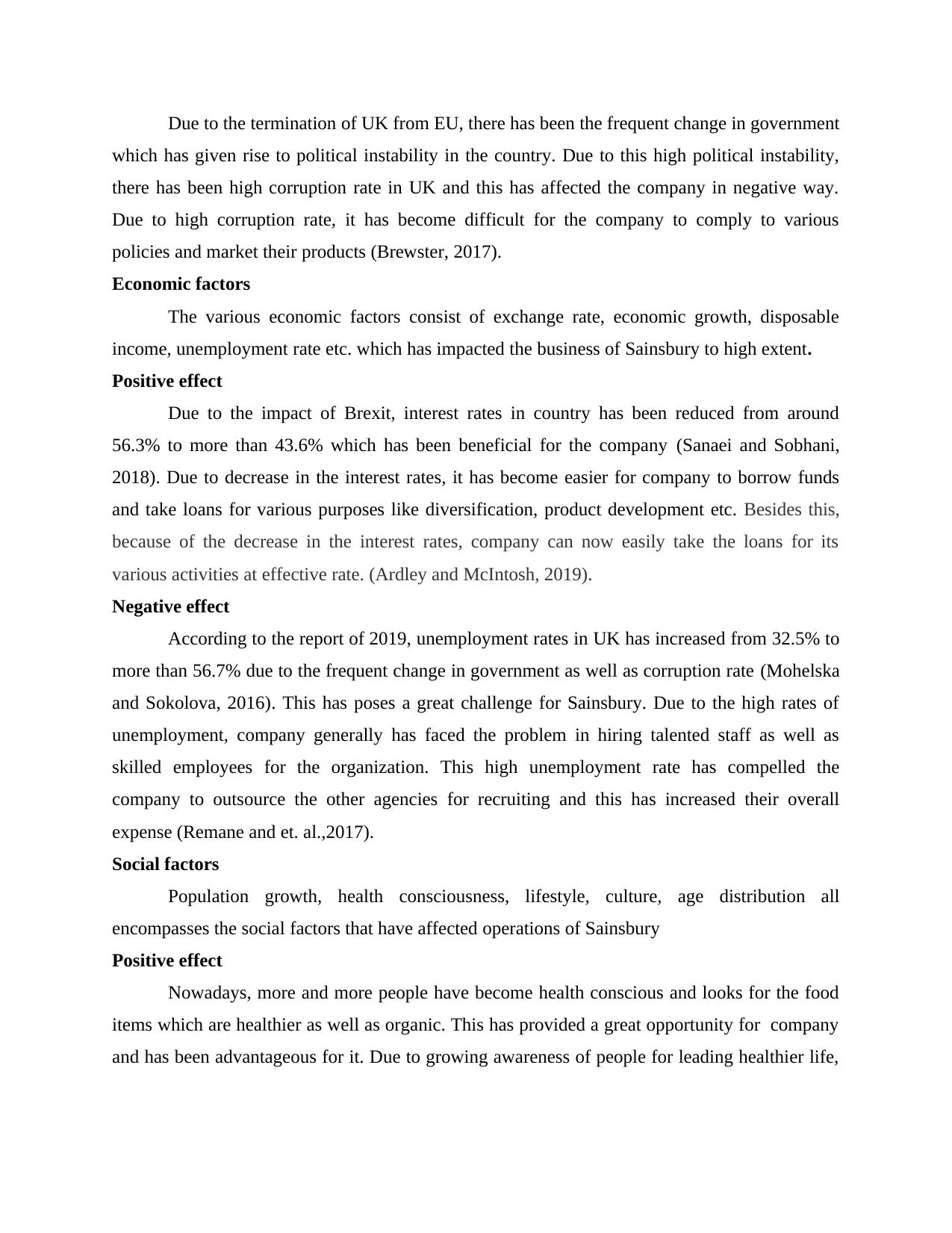
Due to the termination of UK from EU, there has been the frequent change in government
which has given rise to political instability in the country. Due to this high political instability,
there has been high corruption rate in UK and this has affected the company in negative way.
Due to high corruption rate, it has become difficult for the company to comply to various
policies and market their products (Brewster, 2017).
Economic factors
The various economic factors consist of exchange rate, economic growth, disposable
income, unemployment rate etc. which has impacted the business of Sainsbury to high extent.
Positive effect
Due to the impact of Brexit, interest rates in country has been reduced from around
56.3% to more than 43.6% which has been beneficial for the company (Sanaei and Sobhani,
2018). Due to decrease in the interest rates, it has become easier for company to borrow funds
and take loans for various purposes like diversification, product development etc. Besides this,
because of the decrease in the interest rates, company can now easily take the loans for its
various activities at effective rate. (Ardley and McIntosh, 2019).
Negative effect
According to the report of 2019, unemployment rates in UK has increased from 32.5% to
more than 56.7% due to the frequent change in government as well as corruption rate (Mohelska
and Sokolova, 2016). This has poses a great challenge for Sainsbury. Due to the high rates of
unemployment, company generally has faced the problem in hiring talented staff as well as
skilled employees for the organization. This high unemployment rate has compelled the
company to outsource the other agencies for recruiting and this has increased their overall
expense (Remane and et. al.,2017).
Social factors
Population growth, health consciousness, lifestyle, culture, age distribution all
encompasses the social factors that have affected operations of Sainsbury
Positive effect
Nowadays, more and more people have become health conscious and looks for the food
items which are healthier as well as organic. This has provided a great opportunity for company
and has been advantageous for it. Due to growing awareness of people for leading healthier life,
which has given rise to political instability in the country. Due to this high political instability,
there has been high corruption rate in UK and this has affected the company in negative way.
Due to high corruption rate, it has become difficult for the company to comply to various
policies and market their products (Brewster, 2017).
Economic factors
The various economic factors consist of exchange rate, economic growth, disposable
income, unemployment rate etc. which has impacted the business of Sainsbury to high extent.
Positive effect
Due to the impact of Brexit, interest rates in country has been reduced from around
56.3% to more than 43.6% which has been beneficial for the company (Sanaei and Sobhani,
2018). Due to decrease in the interest rates, it has become easier for company to borrow funds
and take loans for various purposes like diversification, product development etc. Besides this,
because of the decrease in the interest rates, company can now easily take the loans for its
various activities at effective rate. (Ardley and McIntosh, 2019).
Negative effect
According to the report of 2019, unemployment rates in UK has increased from 32.5% to
more than 56.7% due to the frequent change in government as well as corruption rate (Mohelska
and Sokolova, 2016). This has poses a great challenge for Sainsbury. Due to the high rates of
unemployment, company generally has faced the problem in hiring talented staff as well as
skilled employees for the organization. This high unemployment rate has compelled the
company to outsource the other agencies for recruiting and this has increased their overall
expense (Remane and et. al.,2017).
Social factors
Population growth, health consciousness, lifestyle, culture, age distribution all
encompasses the social factors that have affected operations of Sainsbury
Positive effect
Nowadays, more and more people have become health conscious and looks for the food
items which are healthier as well as organic. This has provided a great opportunity for company
and has been advantageous for it. Due to growing awareness of people for leading healthier life,
Paraphrase This Document
Need a fresh take? Get an instant paraphrase of this document with our AI Paraphraser
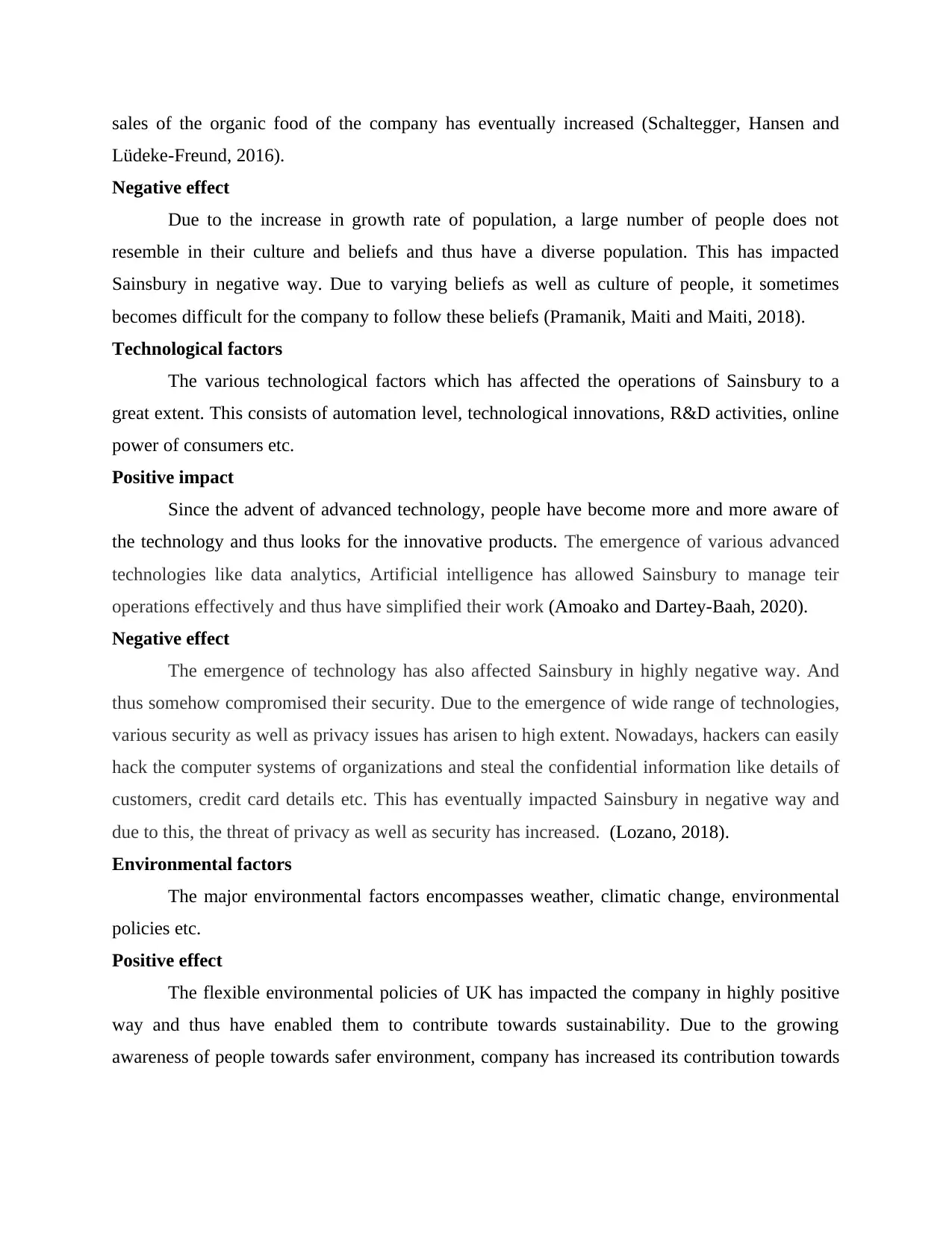
sales of the organic food of the company has eventually increased (Schaltegger, Hansen and
Lüdeke-Freund, 2016).
Negative effect
Due to the increase in growth rate of population, a large number of people does not
resemble in their culture and beliefs and thus have a diverse population. This has impacted
Sainsbury in negative way. Due to varying beliefs as well as culture of people, it sometimes
becomes difficult for the company to follow these beliefs (Pramanik, Maiti and Maiti, 2018).
Technological factors
The various technological factors which has affected the operations of Sainsbury to a
great extent. This consists of automation level, technological innovations, R&D activities, online
power of consumers etc.
Positive impact
Since the advent of advanced technology, people have become more and more aware of
the technology and thus looks for the innovative products. The emergence of various advanced
technologies like data analytics, Artificial intelligence has allowed Sainsbury to manage teir
operations effectively and thus have simplified their work (Amoako and Dartey-Baah, 2020).
Negative effect
The emergence of technology has also affected Sainsbury in highly negative way. And
thus somehow compromised their security. Due to the emergence of wide range of technologies,
various security as well as privacy issues has arisen to high extent. Nowadays, hackers can easily
hack the computer systems of organizations and steal the confidential information like details of
customers, credit card details etc. This has eventually impacted Sainsbury in negative way and
due to this, the threat of privacy as well as security has increased. (Lozano, 2018).
Environmental factors
The major environmental factors encompasses weather, climatic change, environmental
policies etc.
Positive effect
The flexible environmental policies of UK has impacted the company in highly positive
way and thus have enabled them to contribute towards sustainability. Due to the growing
awareness of people towards safer environment, company has increased its contribution towards
Lüdeke-Freund, 2016).
Negative effect
Due to the increase in growth rate of population, a large number of people does not
resemble in their culture and beliefs and thus have a diverse population. This has impacted
Sainsbury in negative way. Due to varying beliefs as well as culture of people, it sometimes
becomes difficult for the company to follow these beliefs (Pramanik, Maiti and Maiti, 2018).
Technological factors
The various technological factors which has affected the operations of Sainsbury to a
great extent. This consists of automation level, technological innovations, R&D activities, online
power of consumers etc.
Positive impact
Since the advent of advanced technology, people have become more and more aware of
the technology and thus looks for the innovative products. The emergence of various advanced
technologies like data analytics, Artificial intelligence has allowed Sainsbury to manage teir
operations effectively and thus have simplified their work (Amoako and Dartey-Baah, 2020).
Negative effect
The emergence of technology has also affected Sainsbury in highly negative way. And
thus somehow compromised their security. Due to the emergence of wide range of technologies,
various security as well as privacy issues has arisen to high extent. Nowadays, hackers can easily
hack the computer systems of organizations and steal the confidential information like details of
customers, credit card details etc. This has eventually impacted Sainsbury in negative way and
due to this, the threat of privacy as well as security has increased. (Lozano, 2018).
Environmental factors
The major environmental factors encompasses weather, climatic change, environmental
policies etc.
Positive effect
The flexible environmental policies of UK has impacted the company in highly positive
way and thus have enabled them to contribute towards sustainability. Due to the growing
awareness of people towards safer environment, company has increased its contribution towards
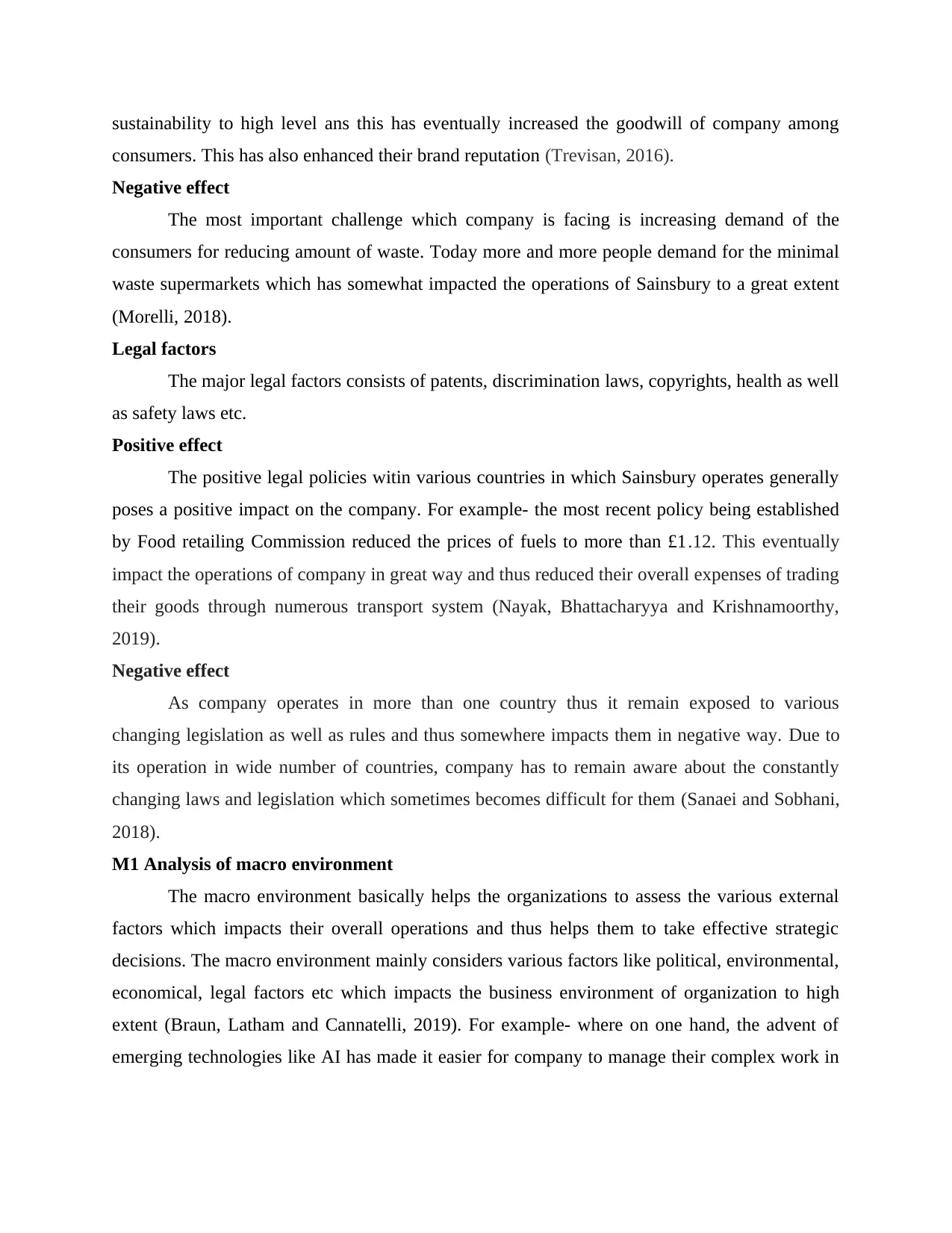
sustainability to high level ans this has eventually increased the goodwill of company among
consumers. This has also enhanced their brand reputation (Trevisan, 2016).
Negative effect
The most important challenge which company is facing is increasing demand of the
consumers for reducing amount of waste. Today more and more people demand for the minimal
waste supermarkets which has somewhat impacted the operations of Sainsbury to a great extent
(Morelli, 2018).
Legal factors
The major legal factors consists of patents, discrimination laws, copyrights, health as well
as safety laws etc.
Positive effect
The positive legal policies witin various countries in which Sainsbury operates generally
poses a positive impact on the company. For example- the most recent policy being established
by Food retailing Commission reduced the prices of fuels to more than £1.12. This eventually
impact the operations of company in great way and thus reduced their overall expenses of trading
their goods through numerous transport system (Nayak, Bhattacharyya and Krishnamoorthy,
2019).
Negative effect
As company operates in more than one country thus it remain exposed to various
changing legislation as well as rules and thus somewhere impacts them in negative way. Due to
its operation in wide number of countries, company has to remain aware about the constantly
changing laws and legislation which sometimes becomes difficult for them (Sanaei and Sobhani,
2018).
M1 Analysis of macro environment
The macro environment basically helps the organizations to assess the various external
factors which impacts their overall operations and thus helps them to take effective strategic
decisions. The macro environment mainly considers various factors like political, environmental,
economical, legal factors etc which impacts the business environment of organization to high
extent (Braun, Latham and Cannatelli, 2019). For example- where on one hand, the advent of
emerging technologies like AI has made it easier for company to manage their complex work in
consumers. This has also enhanced their brand reputation (Trevisan, 2016).
Negative effect
The most important challenge which company is facing is increasing demand of the
consumers for reducing amount of waste. Today more and more people demand for the minimal
waste supermarkets which has somewhat impacted the operations of Sainsbury to a great extent
(Morelli, 2018).
Legal factors
The major legal factors consists of patents, discrimination laws, copyrights, health as well
as safety laws etc.
Positive effect
The positive legal policies witin various countries in which Sainsbury operates generally
poses a positive impact on the company. For example- the most recent policy being established
by Food retailing Commission reduced the prices of fuels to more than £1.12. This eventually
impact the operations of company in great way and thus reduced their overall expenses of trading
their goods through numerous transport system (Nayak, Bhattacharyya and Krishnamoorthy,
2019).
Negative effect
As company operates in more than one country thus it remain exposed to various
changing legislation as well as rules and thus somewhere impacts them in negative way. Due to
its operation in wide number of countries, company has to remain aware about the constantly
changing laws and legislation which sometimes becomes difficult for them (Sanaei and Sobhani,
2018).
M1 Analysis of macro environment
The macro environment basically helps the organizations to assess the various external
factors which impacts their overall operations and thus helps them to take effective strategic
decisions. The macro environment mainly considers various factors like political, environmental,
economical, legal factors etc which impacts the business environment of organization to high
extent (Braun, Latham and Cannatelli, 2019). For example- where on one hand, the advent of
emerging technologies like AI has made it easier for company to manage their complex work in
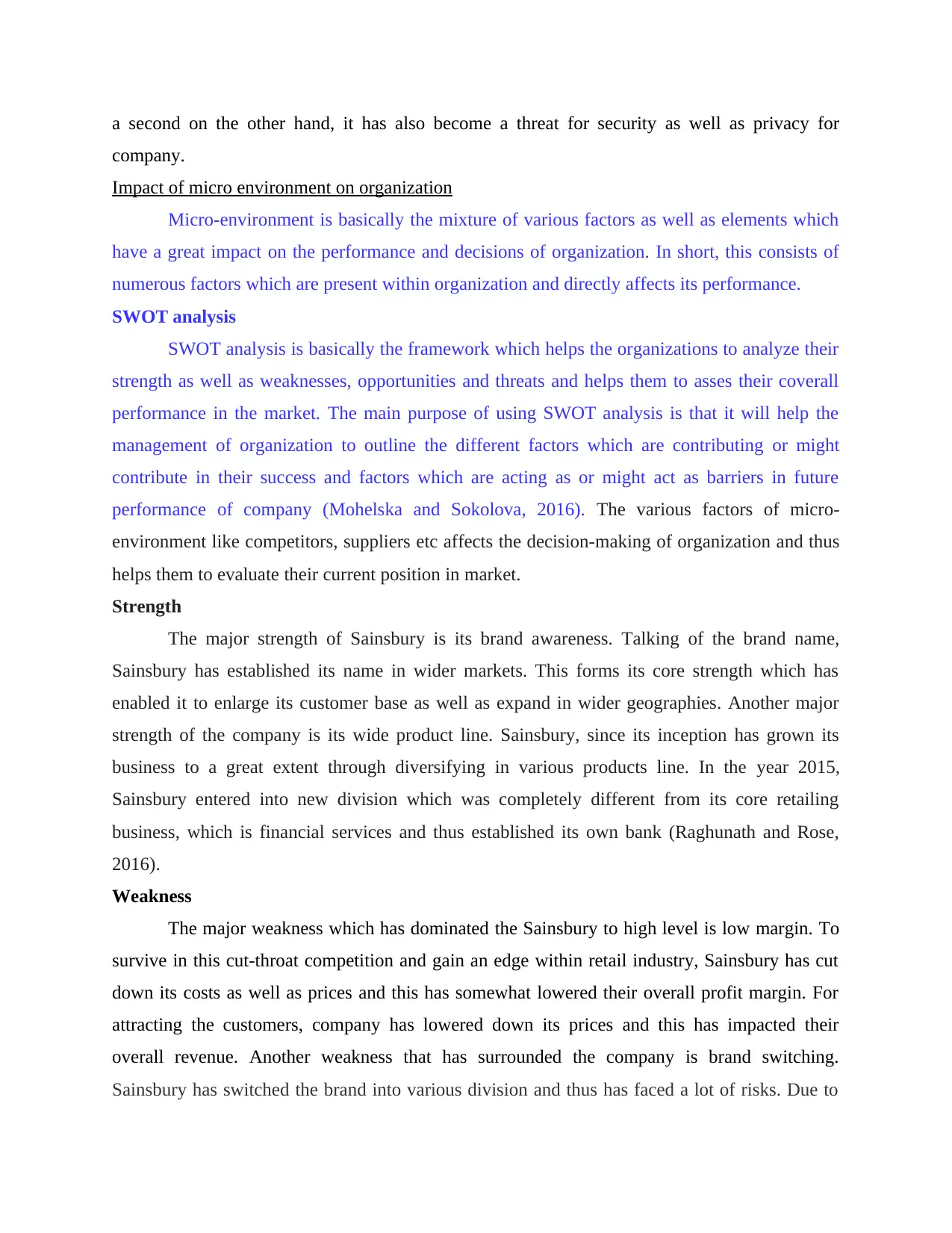
a second on the other hand, it has also become a threat for security as well as privacy for
company.
Impact of micro environment on organization
Micro-environment is basically the mixture of various factors as well as elements which
have a great impact on the performance and decisions of organization. In short, this consists of
numerous factors which are present within organization and directly affects its performance.
SWOT analysis
SWOT analysis is basically the framework which helps the organizations to analyze their
strength as well as weaknesses, opportunities and threats and helps them to asses their coverall
performance in the market. The main purpose of using SWOT analysis is that it will help the
management of organization to outline the different factors which are contributing or might
contribute in their success and factors which are acting as or might act as barriers in future
performance of company (Mohelska and Sokolova, 2016). The various factors of micro-
environment like competitors, suppliers etc affects the decision-making of organization and thus
helps them to evaluate their current position in market.
Strength
The major strength of Sainsbury is its brand awareness. Talking of the brand name,
Sainsbury has established its name in wider markets. This forms its core strength which has
enabled it to enlarge its customer base as well as expand in wider geographies. Another major
strength of the company is its wide product line. Sainsbury, since its inception has grown its
business to a great extent through diversifying in various products line. In the year 2015,
Sainsbury entered into new division which was completely different from its core retailing
business, which is financial services and thus established its own bank (Raghunath and Rose,
2016).
Weakness
The major weakness which has dominated the Sainsbury to high level is low margin. To
survive in this cut-throat competition and gain an edge within retail industry, Sainsbury has cut
down its costs as well as prices and this has somewhat lowered their overall profit margin. For
attracting the customers, company has lowered down its prices and this has impacted their
overall revenue. Another weakness that has surrounded the company is brand switching.
Sainsbury has switched the brand into various division and thus has faced a lot of risks. Due to
company.
Impact of micro environment on organization
Micro-environment is basically the mixture of various factors as well as elements which
have a great impact on the performance and decisions of organization. In short, this consists of
numerous factors which are present within organization and directly affects its performance.
SWOT analysis
SWOT analysis is basically the framework which helps the organizations to analyze their
strength as well as weaknesses, opportunities and threats and helps them to asses their coverall
performance in the market. The main purpose of using SWOT analysis is that it will help the
management of organization to outline the different factors which are contributing or might
contribute in their success and factors which are acting as or might act as barriers in future
performance of company (Mohelska and Sokolova, 2016). The various factors of micro-
environment like competitors, suppliers etc affects the decision-making of organization and thus
helps them to evaluate their current position in market.
Strength
The major strength of Sainsbury is its brand awareness. Talking of the brand name,
Sainsbury has established its name in wider markets. This forms its core strength which has
enabled it to enlarge its customer base as well as expand in wider geographies. Another major
strength of the company is its wide product line. Sainsbury, since its inception has grown its
business to a great extent through diversifying in various products line. In the year 2015,
Sainsbury entered into new division which was completely different from its core retailing
business, which is financial services and thus established its own bank (Raghunath and Rose,
2016).
Weakness
The major weakness which has dominated the Sainsbury to high level is low margin. To
survive in this cut-throat competition and gain an edge within retail industry, Sainsbury has cut
down its costs as well as prices and this has somewhat lowered their overall profit margin. For
attracting the customers, company has lowered down its prices and this has impacted their
overall revenue. Another weakness that has surrounded the company is brand switching.
Sainsbury has switched the brand into various division and thus has faced a lot of risks. Due to
Secure Best Marks with AI Grader
Need help grading? Try our AI Grader for instant feedback on your assignments.
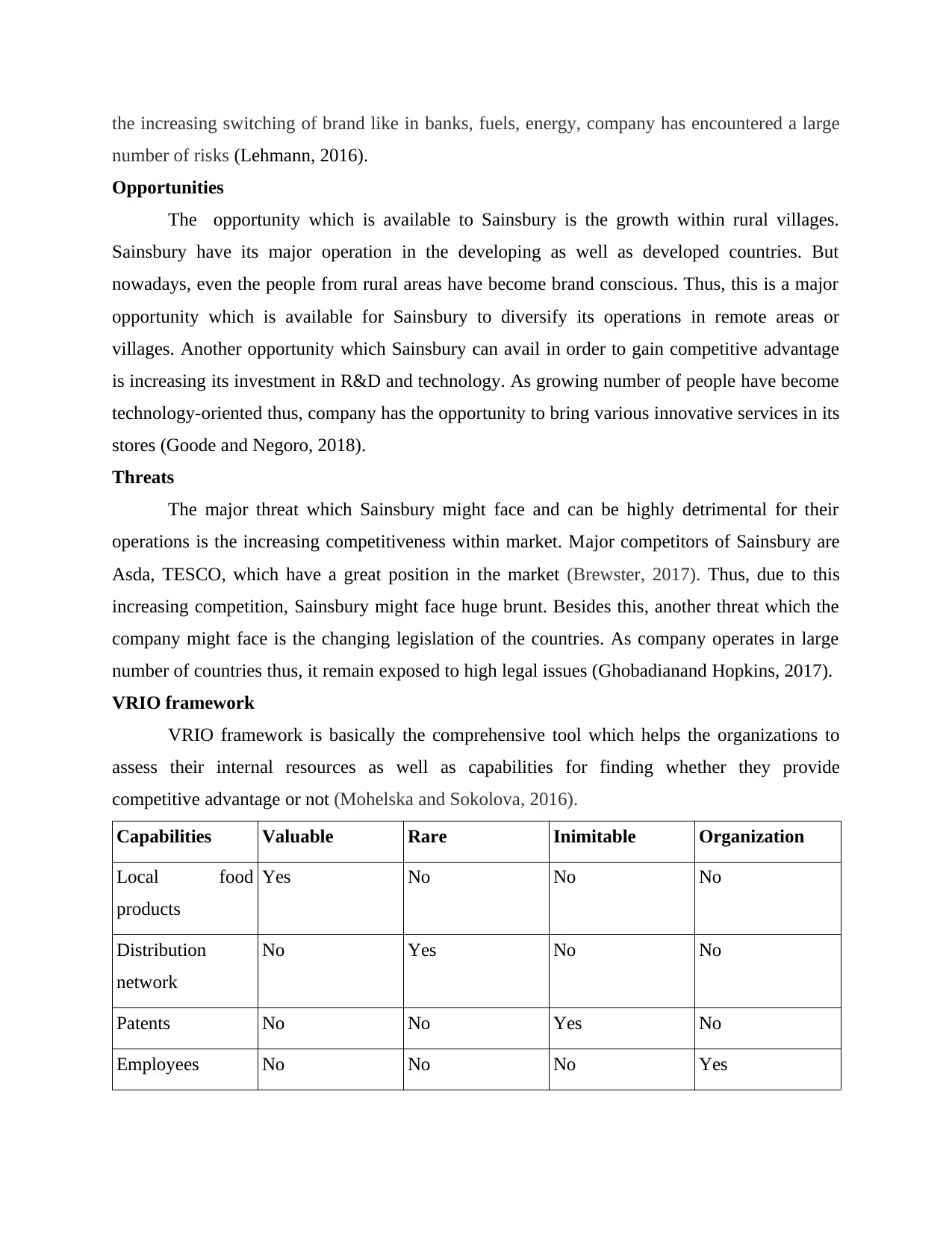
the increasing switching of brand like in banks, fuels, energy, company has encountered a large
number of risks (Lehmann, 2016).
Opportunities
The opportunity which is available to Sainsbury is the growth within rural villages.
Sainsbury have its major operation in the developing as well as developed countries. But
nowadays, even the people from rural areas have become brand conscious. Thus, this is a major
opportunity which is available for Sainsbury to diversify its operations in remote areas or
villages. Another opportunity which Sainsbury can avail in order to gain competitive advantage
is increasing its investment in R&D and technology. As growing number of people have become
technology-oriented thus, company has the opportunity to bring various innovative services in its
stores (Goode and Negoro, 2018).
Threats
The major threat which Sainsbury might face and can be highly detrimental for their
operations is the increasing competitiveness within market. Major competitors of Sainsbury are
Asda, TESCO, which have a great position in the market (Brewster, 2017). Thus, due to this
increasing competition, Sainsbury might face huge brunt. Besides this, another threat which the
company might face is the changing legislation of the countries. As company operates in large
number of countries thus, it remain exposed to high legal issues (Ghobadianand Hopkins, 2017).
VRIO framework
VRIO framework is basically the comprehensive tool which helps the organizations to
assess their internal resources as well as capabilities for finding whether they provide
competitive advantage or not (Mohelska and Sokolova, 2016).
Capabilities Valuable Rare Inimitable Organization
Local food
products
Yes No No No
Distribution
network
No Yes No No
Patents No No Yes No
Employees No No No Yes
number of risks (Lehmann, 2016).
Opportunities
The opportunity which is available to Sainsbury is the growth within rural villages.
Sainsbury have its major operation in the developing as well as developed countries. But
nowadays, even the people from rural areas have become brand conscious. Thus, this is a major
opportunity which is available for Sainsbury to diversify its operations in remote areas or
villages. Another opportunity which Sainsbury can avail in order to gain competitive advantage
is increasing its investment in R&D and technology. As growing number of people have become
technology-oriented thus, company has the opportunity to bring various innovative services in its
stores (Goode and Negoro, 2018).
Threats
The major threat which Sainsbury might face and can be highly detrimental for their
operations is the increasing competitiveness within market. Major competitors of Sainsbury are
Asda, TESCO, which have a great position in the market (Brewster, 2017). Thus, due to this
increasing competition, Sainsbury might face huge brunt. Besides this, another threat which the
company might face is the changing legislation of the countries. As company operates in large
number of countries thus, it remain exposed to high legal issues (Ghobadianand Hopkins, 2017).
VRIO framework
VRIO framework is basically the comprehensive tool which helps the organizations to
assess their internal resources as well as capabilities for finding whether they provide
competitive advantage or not (Mohelska and Sokolova, 2016).
Capabilities Valuable Rare Inimitable Organization
Local food
products
Yes No No No
Distribution
network
No Yes No No
Patents No No Yes No
Employees No No No Yes
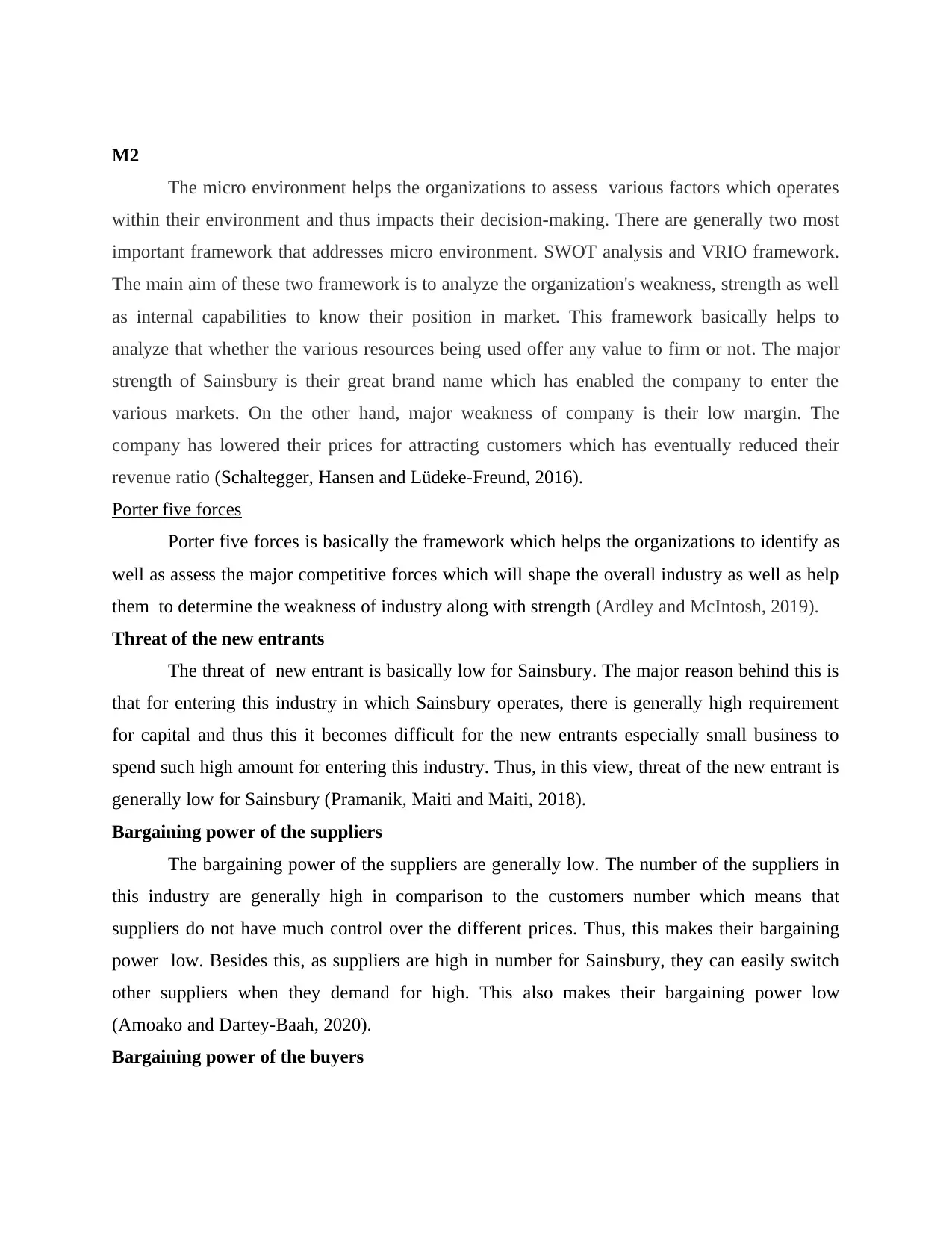
M2
The micro environment helps the organizations to assess various factors which operates
within their environment and thus impacts their decision-making. There are generally two most
important framework that addresses micro environment. SWOT analysis and VRIO framework.
The main aim of these two framework is to analyze the organization's weakness, strength as well
as internal capabilities to know their position in market. This framework basically helps to
analyze that whether the various resources being used offer any value to firm or not. The major
strength of Sainsbury is their great brand name which has enabled the company to enter the
various markets. On the other hand, major weakness of company is their low margin. The
company has lowered their prices for attracting customers which has eventually reduced their
revenue ratio (Schaltegger, Hansen and Lüdeke-Freund, 2016).
Porter five forces
Porter five forces is basically the framework which helps the organizations to identify as
well as assess the major competitive forces which will shape the overall industry as well as help
them to determine the weakness of industry along with strength (Ardley and McIntosh, 2019).
Threat of the new entrants
The threat of new entrant is basically low for Sainsbury. The major reason behind this is
that for entering this industry in which Sainsbury operates, there is generally high requirement
for capital and thus this it becomes difficult for the new entrants especially small business to
spend such high amount for entering this industry. Thus, in this view, threat of the new entrant is
generally low for Sainsbury (Pramanik, Maiti and Maiti, 2018).
Bargaining power of the suppliers
The bargaining power of the suppliers are generally low. The number of the suppliers in
this industry are generally high in comparison to the customers number which means that
suppliers do not have much control over the different prices. Thus, this makes their bargaining
power low. Besides this, as suppliers are high in number for Sainsbury, they can easily switch
other suppliers when they demand for high. This also makes their bargaining power low
(Amoako and Dartey-Baah, 2020).
Bargaining power of the buyers
The micro environment helps the organizations to assess various factors which operates
within their environment and thus impacts their decision-making. There are generally two most
important framework that addresses micro environment. SWOT analysis and VRIO framework.
The main aim of these two framework is to analyze the organization's weakness, strength as well
as internal capabilities to know their position in market. This framework basically helps to
analyze that whether the various resources being used offer any value to firm or not. The major
strength of Sainsbury is their great brand name which has enabled the company to enter the
various markets. On the other hand, major weakness of company is their low margin. The
company has lowered their prices for attracting customers which has eventually reduced their
revenue ratio (Schaltegger, Hansen and Lüdeke-Freund, 2016).
Porter five forces
Porter five forces is basically the framework which helps the organizations to identify as
well as assess the major competitive forces which will shape the overall industry as well as help
them to determine the weakness of industry along with strength (Ardley and McIntosh, 2019).
Threat of the new entrants
The threat of new entrant is basically low for Sainsbury. The major reason behind this is
that for entering this industry in which Sainsbury operates, there is generally high requirement
for capital and thus this it becomes difficult for the new entrants especially small business to
spend such high amount for entering this industry. Thus, in this view, threat of the new entrant is
generally low for Sainsbury (Pramanik, Maiti and Maiti, 2018).
Bargaining power of the suppliers
The bargaining power of the suppliers are generally low. The number of the suppliers in
this industry are generally high in comparison to the customers number which means that
suppliers do not have much control over the different prices. Thus, this makes their bargaining
power low. Besides this, as suppliers are high in number for Sainsbury, they can easily switch
other suppliers when they demand for high. This also makes their bargaining power low
(Amoako and Dartey-Baah, 2020).
Bargaining power of the buyers
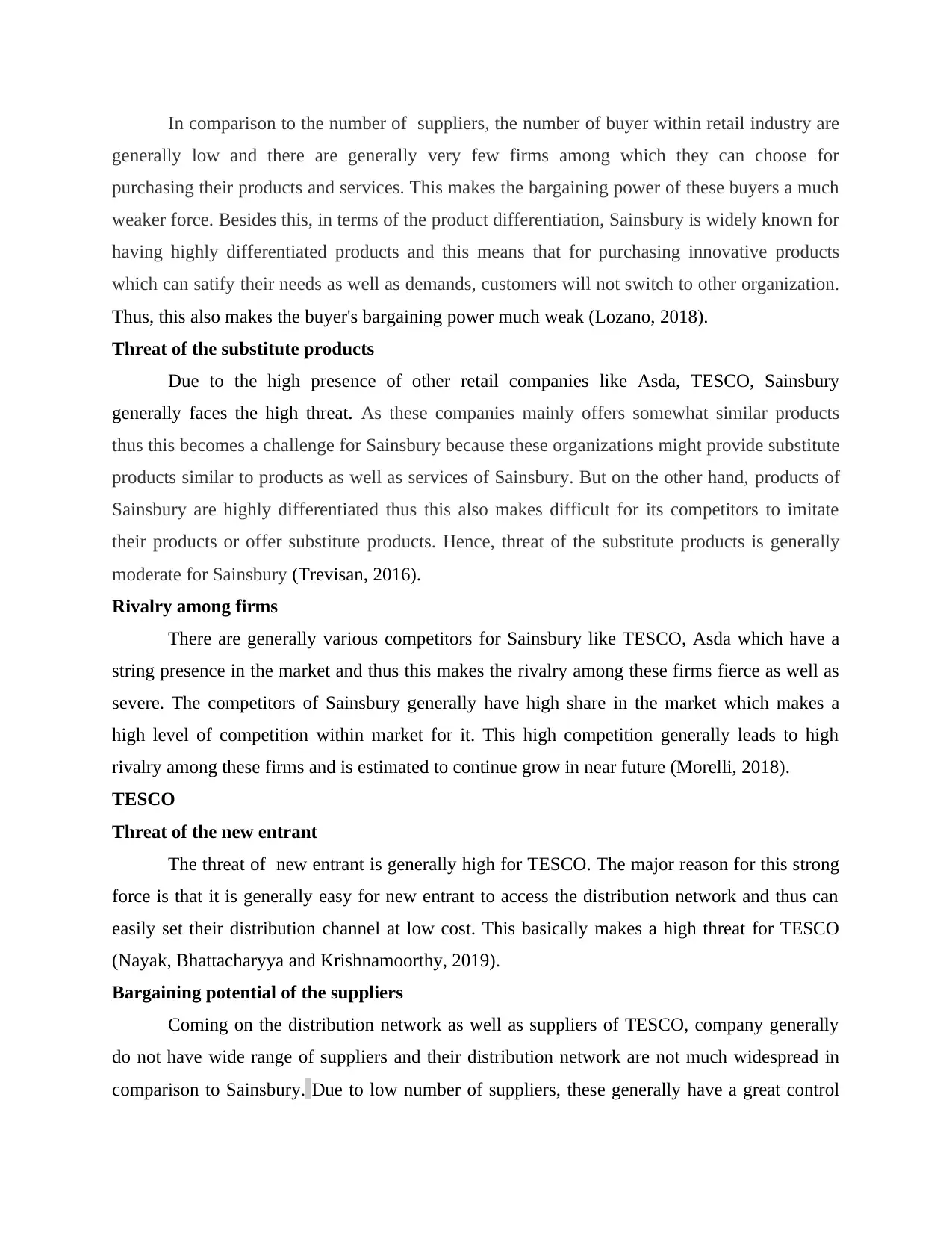
In comparison to the number of suppliers, the number of buyer within retail industry are
generally low and there are generally very few firms among which they can choose for
purchasing their products and services. This makes the bargaining power of these buyers a much
weaker force. Besides this, in terms of the product differentiation, Sainsbury is widely known for
having highly differentiated products and this means that for purchasing innovative products
which can satify their needs as well as demands, customers will not switch to other organization.
Thus, this also makes the buyer's bargaining power much weak (Lozano, 2018).
Threat of the substitute products
Due to the high presence of other retail companies like Asda, TESCO, Sainsbury
generally faces the high threat. As these companies mainly offers somewhat similar products
thus this becomes a challenge for Sainsbury because these organizations might provide substitute
products similar to products as well as services of Sainsbury. But on the other hand, products of
Sainsbury are highly differentiated thus this also makes difficult for its competitors to imitate
their products or offer substitute products. Hence, threat of the substitute products is generally
moderate for Sainsbury (Trevisan, 2016).
Rivalry among firms
There are generally various competitors for Sainsbury like TESCO, Asda which have a
string presence in the market and thus this makes the rivalry among these firms fierce as well as
severe. The competitors of Sainsbury generally have high share in the market which makes a
high level of competition within market for it. This high competition generally leads to high
rivalry among these firms and is estimated to continue grow in near future (Morelli, 2018).
TESCO
Threat of the new entrant
The threat of new entrant is generally high for TESCO. The major reason for this strong
force is that it is generally easy for new entrant to access the distribution network and thus can
easily set their distribution channel at low cost. This basically makes a high threat for TESCO
(Nayak, Bhattacharyya and Krishnamoorthy, 2019).
Bargaining potential of the suppliers
Coming on the distribution network as well as suppliers of TESCO, company generally
do not have wide range of suppliers and their distribution network are not much widespread in
comparison to Sainsbury. Due to low number of suppliers, these generally have a great control
generally low and there are generally very few firms among which they can choose for
purchasing their products and services. This makes the bargaining power of these buyers a much
weaker force. Besides this, in terms of the product differentiation, Sainsbury is widely known for
having highly differentiated products and this means that for purchasing innovative products
which can satify their needs as well as demands, customers will not switch to other organization.
Thus, this also makes the buyer's bargaining power much weak (Lozano, 2018).
Threat of the substitute products
Due to the high presence of other retail companies like Asda, TESCO, Sainsbury
generally faces the high threat. As these companies mainly offers somewhat similar products
thus this becomes a challenge for Sainsbury because these organizations might provide substitute
products similar to products as well as services of Sainsbury. But on the other hand, products of
Sainsbury are highly differentiated thus this also makes difficult for its competitors to imitate
their products or offer substitute products. Hence, threat of the substitute products is generally
moderate for Sainsbury (Trevisan, 2016).
Rivalry among firms
There are generally various competitors for Sainsbury like TESCO, Asda which have a
string presence in the market and thus this makes the rivalry among these firms fierce as well as
severe. The competitors of Sainsbury generally have high share in the market which makes a
high level of competition within market for it. This high competition generally leads to high
rivalry among these firms and is estimated to continue grow in near future (Morelli, 2018).
TESCO
Threat of the new entrant
The threat of new entrant is generally high for TESCO. The major reason for this strong
force is that it is generally easy for new entrant to access the distribution network and thus can
easily set their distribution channel at low cost. This basically makes a high threat for TESCO
(Nayak, Bhattacharyya and Krishnamoorthy, 2019).
Bargaining potential of the suppliers
Coming on the distribution network as well as suppliers of TESCO, company generally
do not have wide range of suppliers and their distribution network are not much widespread in
comparison to Sainsbury. Due to low number of suppliers, these generally have a great control
Paraphrase This Document
Need a fresh take? Get an instant paraphrase of this document with our AI Paraphraser
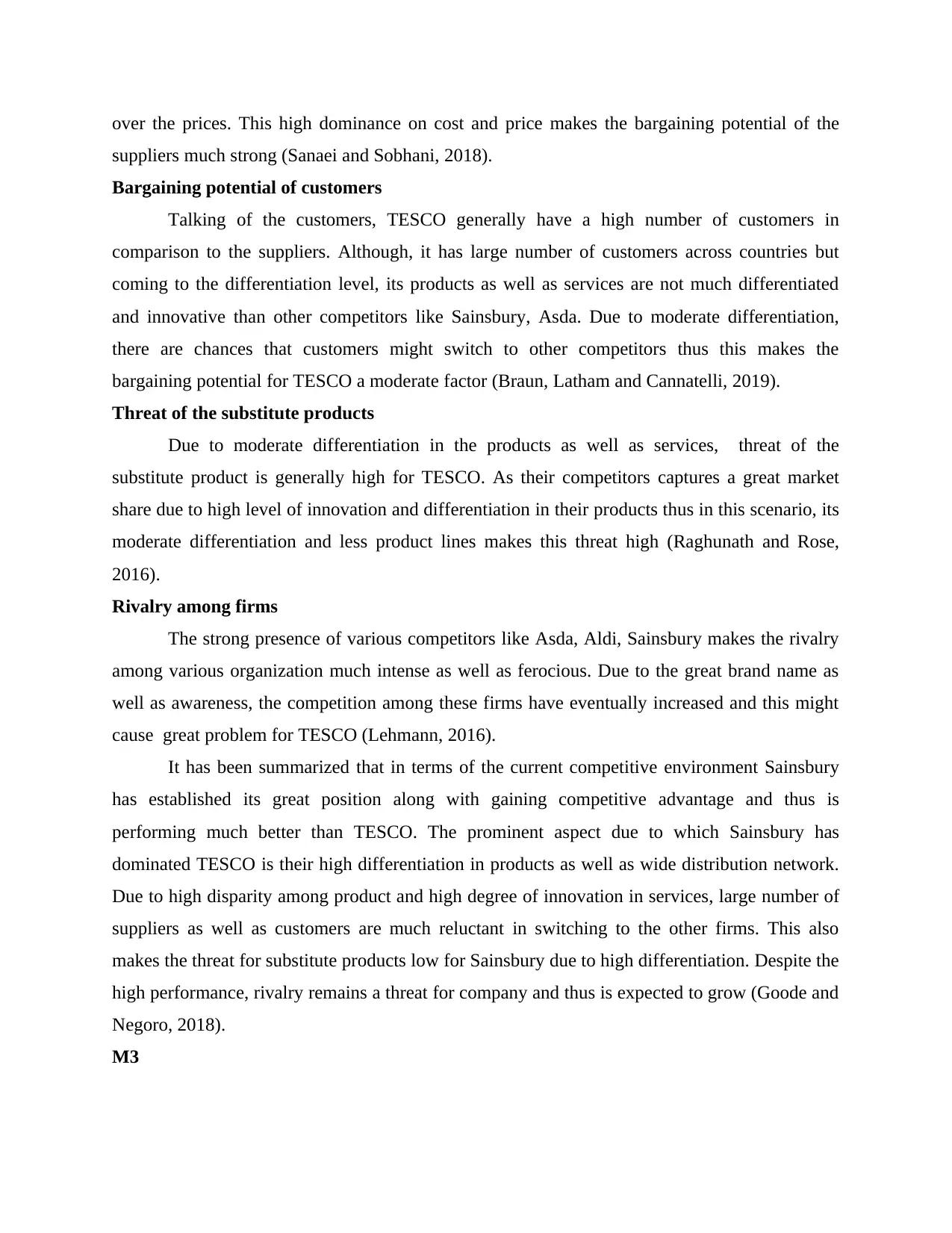
over the prices. This high dominance on cost and price makes the bargaining potential of the
suppliers much strong (Sanaei and Sobhani, 2018).
Bargaining potential of customers
Talking of the customers, TESCO generally have a high number of customers in
comparison to the suppliers. Although, it has large number of customers across countries but
coming to the differentiation level, its products as well as services are not much differentiated
and innovative than other competitors like Sainsbury, Asda. Due to moderate differentiation,
there are chances that customers might switch to other competitors thus this makes the
bargaining potential for TESCO a moderate factor (Braun, Latham and Cannatelli, 2019).
Threat of the substitute products
Due to moderate differentiation in the products as well as services, threat of the
substitute product is generally high for TESCO. As their competitors captures a great market
share due to high level of innovation and differentiation in their products thus in this scenario, its
moderate differentiation and less product lines makes this threat high (Raghunath and Rose,
2016).
Rivalry among firms
The strong presence of various competitors like Asda, Aldi, Sainsbury makes the rivalry
among various organization much intense as well as ferocious. Due to the great brand name as
well as awareness, the competition among these firms have eventually increased and this might
cause great problem for TESCO (Lehmann, 2016).
It has been summarized that in terms of the current competitive environment Sainsbury
has established its great position along with gaining competitive advantage and thus is
performing much better than TESCO. The prominent aspect due to which Sainsbury has
dominated TESCO is their high differentiation in products as well as wide distribution network.
Due to high disparity among product and high degree of innovation in services, large number of
suppliers as well as customers are much reluctant in switching to the other firms. This also
makes the threat for substitute products low for Sainsbury due to high differentiation. Despite the
high performance, rivalry remains a threat for company and thus is expected to grow (Goode and
Negoro, 2018).
M3
suppliers much strong (Sanaei and Sobhani, 2018).
Bargaining potential of customers
Talking of the customers, TESCO generally have a high number of customers in
comparison to the suppliers. Although, it has large number of customers across countries but
coming to the differentiation level, its products as well as services are not much differentiated
and innovative than other competitors like Sainsbury, Asda. Due to moderate differentiation,
there are chances that customers might switch to other competitors thus this makes the
bargaining potential for TESCO a moderate factor (Braun, Latham and Cannatelli, 2019).
Threat of the substitute products
Due to moderate differentiation in the products as well as services, threat of the
substitute product is generally high for TESCO. As their competitors captures a great market
share due to high level of innovation and differentiation in their products thus in this scenario, its
moderate differentiation and less product lines makes this threat high (Raghunath and Rose,
2016).
Rivalry among firms
The strong presence of various competitors like Asda, Aldi, Sainsbury makes the rivalry
among various organization much intense as well as ferocious. Due to the great brand name as
well as awareness, the competition among these firms have eventually increased and this might
cause great problem for TESCO (Lehmann, 2016).
It has been summarized that in terms of the current competitive environment Sainsbury
has established its great position along with gaining competitive advantage and thus is
performing much better than TESCO. The prominent aspect due to which Sainsbury has
dominated TESCO is their high differentiation in products as well as wide distribution network.
Due to high disparity among product and high degree of innovation in services, large number of
suppliers as well as customers are much reluctant in switching to the other firms. This also
makes the threat for substitute products low for Sainsbury due to high differentiation. Despite the
high performance, rivalry remains a threat for company and thus is expected to grow (Goode and
Negoro, 2018).
M3
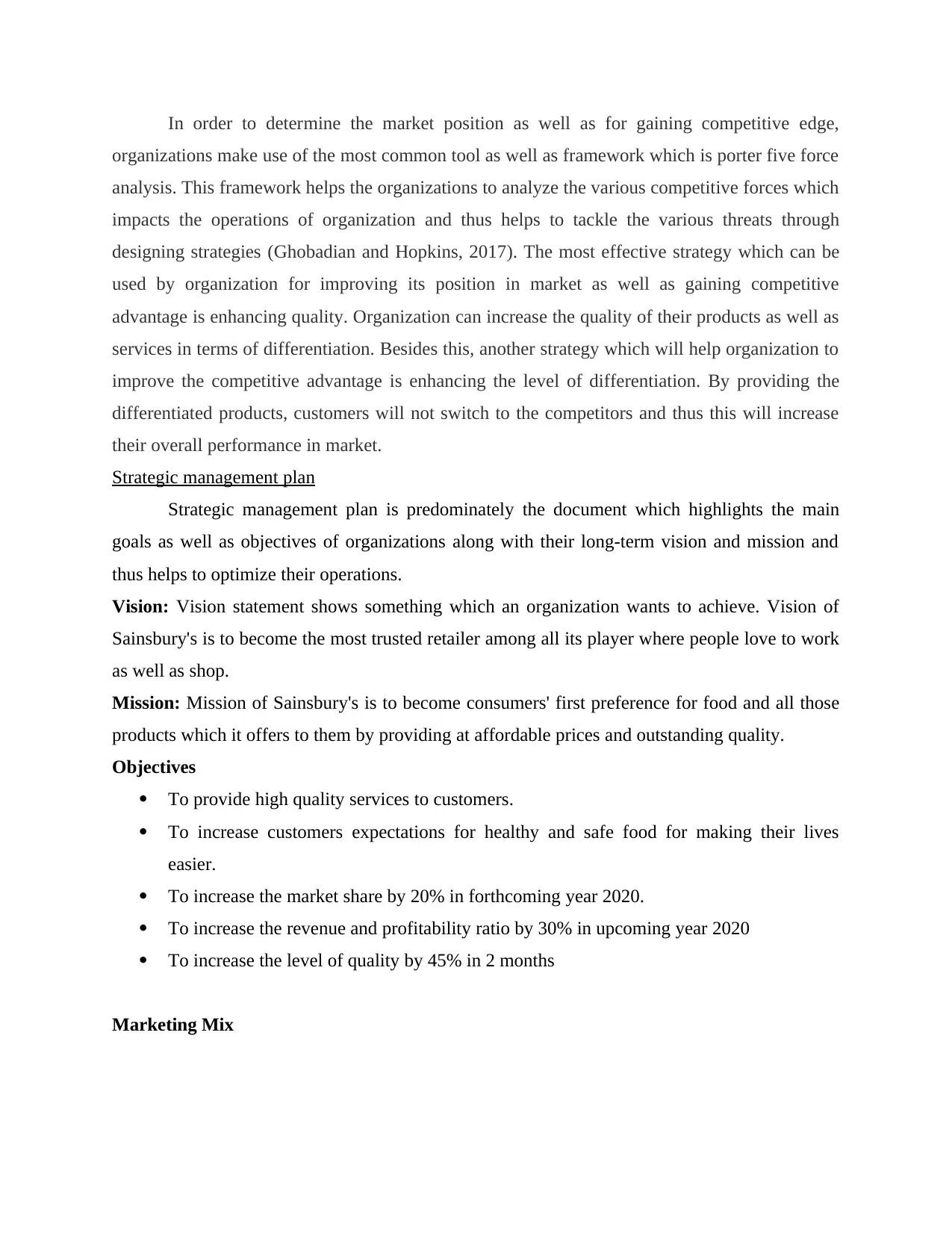
In order to determine the market position as well as for gaining competitive edge,
organizations make use of the most common tool as well as framework which is porter five force
analysis. This framework helps the organizations to analyze the various competitive forces which
impacts the operations of organization and thus helps to tackle the various threats through
designing strategies (Ghobadian and Hopkins, 2017). The most effective strategy which can be
used by organization for improving its position in market as well as gaining competitive
advantage is enhancing quality. Organization can increase the quality of their products as well as
services in terms of differentiation. Besides this, another strategy which will help organization to
improve the competitive advantage is enhancing the level of differentiation. By providing the
differentiated products, customers will not switch to the competitors and thus this will increase
their overall performance in market.
Strategic management plan
Strategic management plan is predominately the document which highlights the main
goals as well as objectives of organizations along with their long-term vision and mission and
thus helps to optimize their operations.
Vision: Vision statement shows something which an organization wants to achieve. Vision of
Sainsbury's is to become the most trusted retailer among all its player where people love to work
as well as shop.
Mission: Mission of Sainsbury's is to become consumers' first preference for food and all those
products which it offers to them by providing at affordable prices and outstanding quality.
Objectives
To provide high quality services to customers.
To increase customers expectations for healthy and safe food for making their lives
easier.
To increase the market share by 20% in forthcoming year 2020.
To increase the revenue and profitability ratio by 30% in upcoming year 2020
To increase the level of quality by 45% in 2 months
Marketing Mix
organizations make use of the most common tool as well as framework which is porter five force
analysis. This framework helps the organizations to analyze the various competitive forces which
impacts the operations of organization and thus helps to tackle the various threats through
designing strategies (Ghobadian and Hopkins, 2017). The most effective strategy which can be
used by organization for improving its position in market as well as gaining competitive
advantage is enhancing quality. Organization can increase the quality of their products as well as
services in terms of differentiation. Besides this, another strategy which will help organization to
improve the competitive advantage is enhancing the level of differentiation. By providing the
differentiated products, customers will not switch to the competitors and thus this will increase
their overall performance in market.
Strategic management plan
Strategic management plan is predominately the document which highlights the main
goals as well as objectives of organizations along with their long-term vision and mission and
thus helps to optimize their operations.
Vision: Vision statement shows something which an organization wants to achieve. Vision of
Sainsbury's is to become the most trusted retailer among all its player where people love to work
as well as shop.
Mission: Mission of Sainsbury's is to become consumers' first preference for food and all those
products which it offers to them by providing at affordable prices and outstanding quality.
Objectives
To provide high quality services to customers.
To increase customers expectations for healthy and safe food for making their lives
easier.
To increase the market share by 20% in forthcoming year 2020.
To increase the revenue and profitability ratio by 30% in upcoming year 2020
To increase the level of quality by 45% in 2 months
Marketing Mix
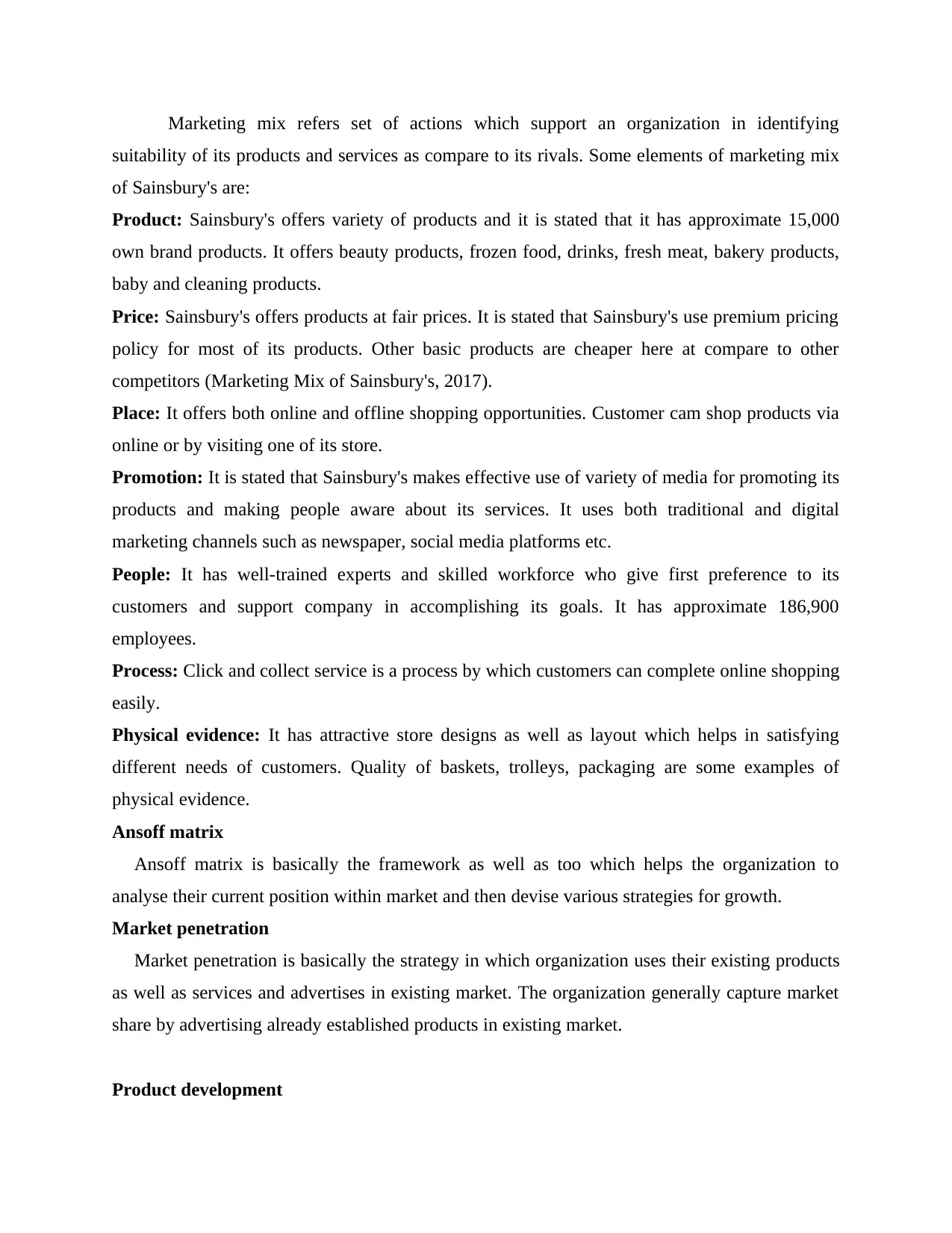
Marketing mix refers set of actions which support an organization in identifying
suitability of its products and services as compare to its rivals. Some elements of marketing mix
of Sainsbury's are:
Product: Sainsbury's offers variety of products and it is stated that it has approximate 15,000
own brand products. It offers beauty products, frozen food, drinks, fresh meat, bakery products,
baby and cleaning products.
Price: Sainsbury's offers products at fair prices. It is stated that Sainsbury's use premium pricing
policy for most of its products. Other basic products are cheaper here at compare to other
competitors (Marketing Mix of Sainsbury's, 2017).
Place: It offers both online and offline shopping opportunities. Customer cam shop products via
online or by visiting one of its store.
Promotion: It is stated that Sainsbury's makes effective use of variety of media for promoting its
products and making people aware about its services. It uses both traditional and digital
marketing channels such as newspaper, social media platforms etc.
People: It has well-trained experts and skilled workforce who give first preference to its
customers and support company in accomplishing its goals. It has approximate 186,900
employees.
Process: Click and collect service is a process by which customers can complete online shopping
easily.
Physical evidence: It has attractive store designs as well as layout which helps in satisfying
different needs of customers. Quality of baskets, trolleys, packaging are some examples of
physical evidence.
Ansoff matrix
Ansoff matrix is basically the framework as well as too which helps the organization to
analyse their current position within market and then devise various strategies for growth.
Market penetration
Market penetration is basically the strategy in which organization uses their existing products
as well as services and advertises in existing market. The organization generally capture market
share by advertising already established products in existing market.
Product development
suitability of its products and services as compare to its rivals. Some elements of marketing mix
of Sainsbury's are:
Product: Sainsbury's offers variety of products and it is stated that it has approximate 15,000
own brand products. It offers beauty products, frozen food, drinks, fresh meat, bakery products,
baby and cleaning products.
Price: Sainsbury's offers products at fair prices. It is stated that Sainsbury's use premium pricing
policy for most of its products. Other basic products are cheaper here at compare to other
competitors (Marketing Mix of Sainsbury's, 2017).
Place: It offers both online and offline shopping opportunities. Customer cam shop products via
online or by visiting one of its store.
Promotion: It is stated that Sainsbury's makes effective use of variety of media for promoting its
products and making people aware about its services. It uses both traditional and digital
marketing channels such as newspaper, social media platforms etc.
People: It has well-trained experts and skilled workforce who give first preference to its
customers and support company in accomplishing its goals. It has approximate 186,900
employees.
Process: Click and collect service is a process by which customers can complete online shopping
easily.
Physical evidence: It has attractive store designs as well as layout which helps in satisfying
different needs of customers. Quality of baskets, trolleys, packaging are some examples of
physical evidence.
Ansoff matrix
Ansoff matrix is basically the framework as well as too which helps the organization to
analyse their current position within market and then devise various strategies for growth.
Market penetration
Market penetration is basically the strategy in which organization uses their existing products
as well as services and advertises in existing market. The organization generally capture market
share by advertising already established products in existing market.
Product development
Secure Best Marks with AI Grader
Need help grading? Try our AI Grader for instant feedback on your assignments.
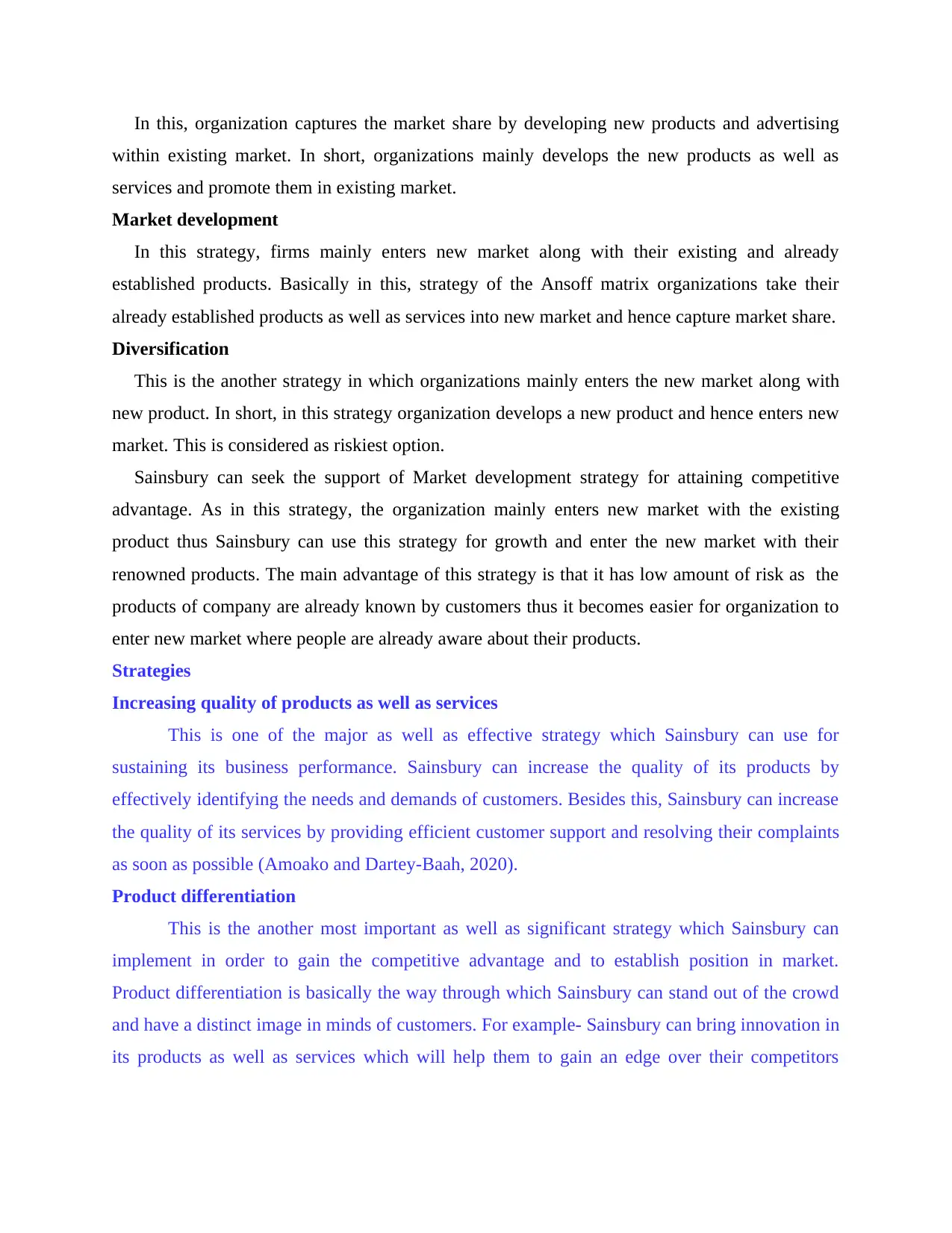
In this, organization captures the market share by developing new products and advertising
within existing market. In short, organizations mainly develops the new products as well as
services and promote them in existing market.
Market development
In this strategy, firms mainly enters new market along with their existing and already
established products. Basically in this, strategy of the Ansoff matrix organizations take their
already established products as well as services into new market and hence capture market share.
Diversification
This is the another strategy in which organizations mainly enters the new market along with
new product. In short, in this strategy organization develops a new product and hence enters new
market. This is considered as riskiest option.
Sainsbury can seek the support of Market development strategy for attaining competitive
advantage. As in this strategy, the organization mainly enters new market with the existing
product thus Sainsbury can use this strategy for growth and enter the new market with their
renowned products. The main advantage of this strategy is that it has low amount of risk as the
products of company are already known by customers thus it becomes easier for organization to
enter new market where people are already aware about their products.
Strategies
Increasing quality of products as well as services
This is one of the major as well as effective strategy which Sainsbury can use for
sustaining its business performance. Sainsbury can increase the quality of its products by
effectively identifying the needs and demands of customers. Besides this, Sainsbury can increase
the quality of its services by providing efficient customer support and resolving their complaints
as soon as possible (Amoako and Dartey-Baah, 2020).
Product differentiation
This is the another most important as well as significant strategy which Sainsbury can
implement in order to gain the competitive advantage and to establish position in market.
Product differentiation is basically the way through which Sainsbury can stand out of the crowd
and have a distinct image in minds of customers. For example- Sainsbury can bring innovation in
its products as well as services which will help them to gain an edge over their competitors
within existing market. In short, organizations mainly develops the new products as well as
services and promote them in existing market.
Market development
In this strategy, firms mainly enters new market along with their existing and already
established products. Basically in this, strategy of the Ansoff matrix organizations take their
already established products as well as services into new market and hence capture market share.
Diversification
This is the another strategy in which organizations mainly enters the new market along with
new product. In short, in this strategy organization develops a new product and hence enters new
market. This is considered as riskiest option.
Sainsbury can seek the support of Market development strategy for attaining competitive
advantage. As in this strategy, the organization mainly enters new market with the existing
product thus Sainsbury can use this strategy for growth and enter the new market with their
renowned products. The main advantage of this strategy is that it has low amount of risk as the
products of company are already known by customers thus it becomes easier for organization to
enter new market where people are already aware about their products.
Strategies
Increasing quality of products as well as services
This is one of the major as well as effective strategy which Sainsbury can use for
sustaining its business performance. Sainsbury can increase the quality of its products by
effectively identifying the needs and demands of customers. Besides this, Sainsbury can increase
the quality of its services by providing efficient customer support and resolving their complaints
as soon as possible (Amoako and Dartey-Baah, 2020).
Product differentiation
This is the another most important as well as significant strategy which Sainsbury can
implement in order to gain the competitive advantage and to establish position in market.
Product differentiation is basically the way through which Sainsbury can stand out of the crowd
and have a distinct image in minds of customers. For example- Sainsbury can bring innovation in
its products as well as services which will help them to gain an edge over their competitors
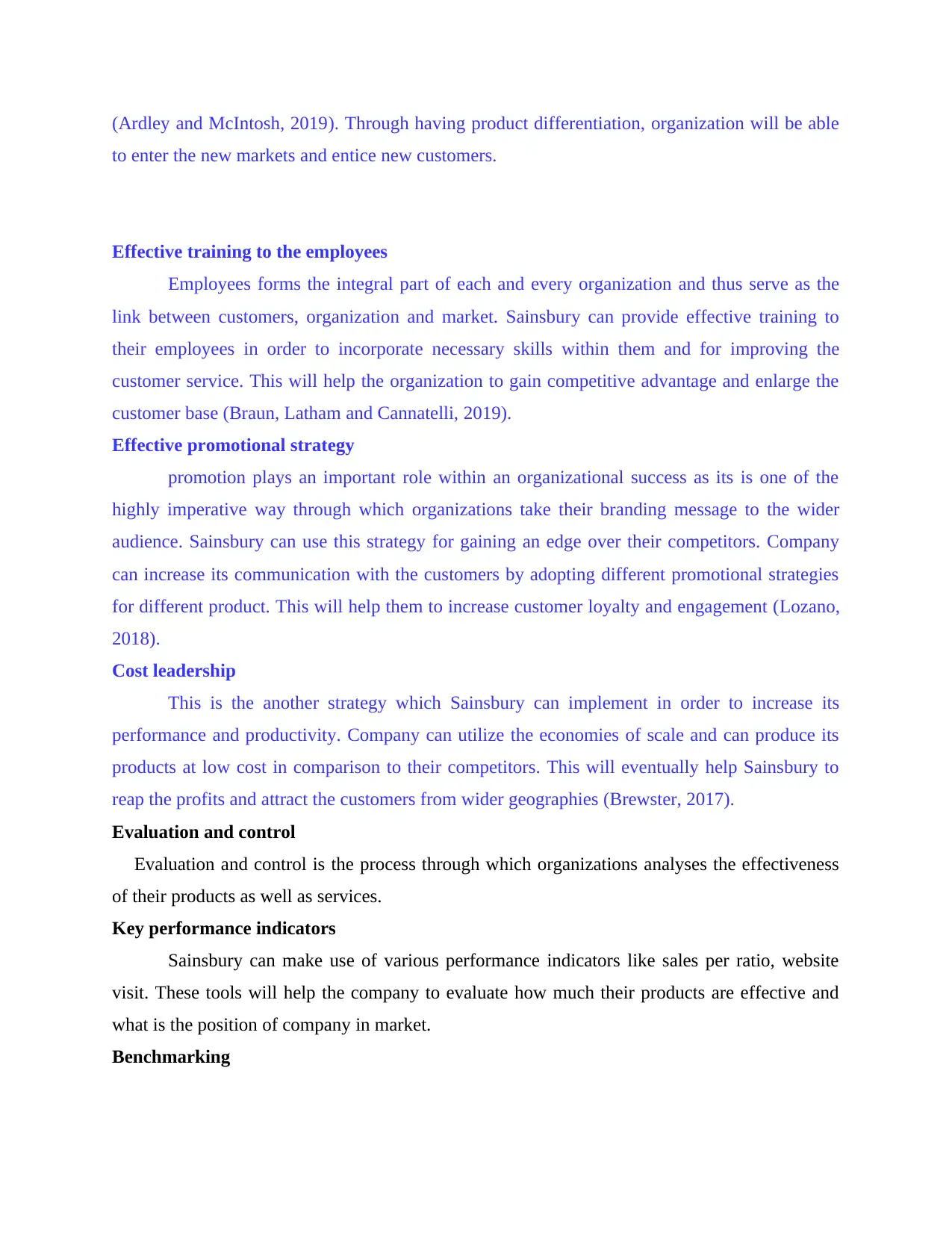
(Ardley and McIntosh, 2019). Through having product differentiation, organization will be able
to enter the new markets and entice new customers.
Effective training to the employees
Employees forms the integral part of each and every organization and thus serve as the
link between customers, organization and market. Sainsbury can provide effective training to
their employees in order to incorporate necessary skills within them and for improving the
customer service. This will help the organization to gain competitive advantage and enlarge the
customer base (Braun, Latham and Cannatelli, 2019).
Effective promotional strategy
promotion plays an important role within an organizational success as its is one of the
highly imperative way through which organizations take their branding message to the wider
audience. Sainsbury can use this strategy for gaining an edge over their competitors. Company
can increase its communication with the customers by adopting different promotional strategies
for different product. This will help them to increase customer loyalty and engagement (Lozano,
2018).
Cost leadership
This is the another strategy which Sainsbury can implement in order to increase its
performance and productivity. Company can utilize the economies of scale and can produce its
products at low cost in comparison to their competitors. This will eventually help Sainsbury to
reap the profits and attract the customers from wider geographies (Brewster, 2017).
Evaluation and control
Evaluation and control is the process through which organizations analyses the effectiveness
of their products as well as services.
Key performance indicators
Sainsbury can make use of various performance indicators like sales per ratio, website
visit. These tools will help the company to evaluate how much their products are effective and
what is the position of company in market.
Benchmarking
to enter the new markets and entice new customers.
Effective training to the employees
Employees forms the integral part of each and every organization and thus serve as the
link between customers, organization and market. Sainsbury can provide effective training to
their employees in order to incorporate necessary skills within them and for improving the
customer service. This will help the organization to gain competitive advantage and enlarge the
customer base (Braun, Latham and Cannatelli, 2019).
Effective promotional strategy
promotion plays an important role within an organizational success as its is one of the
highly imperative way through which organizations take their branding message to the wider
audience. Sainsbury can use this strategy for gaining an edge over their competitors. Company
can increase its communication with the customers by adopting different promotional strategies
for different product. This will help them to increase customer loyalty and engagement (Lozano,
2018).
Cost leadership
This is the another strategy which Sainsbury can implement in order to increase its
performance and productivity. Company can utilize the economies of scale and can produce its
products at low cost in comparison to their competitors. This will eventually help Sainsbury to
reap the profits and attract the customers from wider geographies (Brewster, 2017).
Evaluation and control
Evaluation and control is the process through which organizations analyses the effectiveness
of their products as well as services.
Key performance indicators
Sainsbury can make use of various performance indicators like sales per ratio, website
visit. These tools will help the company to evaluate how much their products are effective and
what is the position of company in market.
Benchmarking
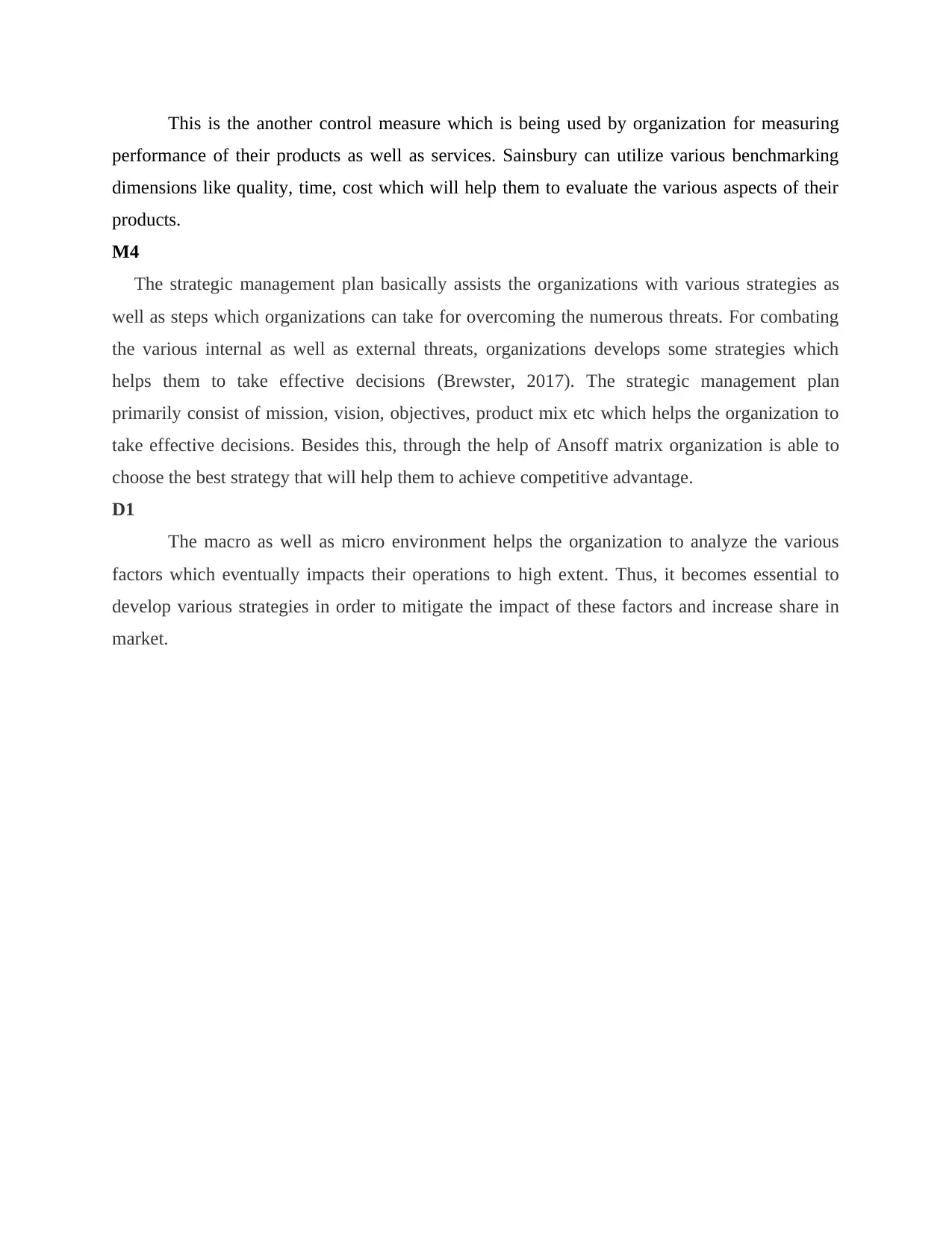
This is the another control measure which is being used by organization for measuring
performance of their products as well as services. Sainsbury can utilize various benchmarking
dimensions like quality, time, cost which will help them to evaluate the various aspects of their
products.
M4
The strategic management plan basically assists the organizations with various strategies as
well as steps which organizations can take for overcoming the numerous threats. For combating
the various internal as well as external threats, organizations develops some strategies which
helps them to take effective decisions (Brewster, 2017). The strategic management plan
primarily consist of mission, vision, objectives, product mix etc which helps the organization to
take effective decisions. Besides this, through the help of Ansoff matrix organization is able to
choose the best strategy that will help them to achieve competitive advantage.
D1
The macro as well as micro environment helps the organization to analyze the various
factors which eventually impacts their operations to high extent. Thus, it becomes essential to
develop various strategies in order to mitigate the impact of these factors and increase share in
market.
performance of their products as well as services. Sainsbury can utilize various benchmarking
dimensions like quality, time, cost which will help them to evaluate the various aspects of their
products.
M4
The strategic management plan basically assists the organizations with various strategies as
well as steps which organizations can take for overcoming the numerous threats. For combating
the various internal as well as external threats, organizations develops some strategies which
helps them to take effective decisions (Brewster, 2017). The strategic management plan
primarily consist of mission, vision, objectives, product mix etc which helps the organization to
take effective decisions. Besides this, through the help of Ansoff matrix organization is able to
choose the best strategy that will help them to achieve competitive advantage.
D1
The macro as well as micro environment helps the organization to analyze the various
factors which eventually impacts their operations to high extent. Thus, it becomes essential to
develop various strategies in order to mitigate the impact of these factors and increase share in
market.
Paraphrase This Document
Need a fresh take? Get an instant paraphrase of this document with our AI Paraphraser
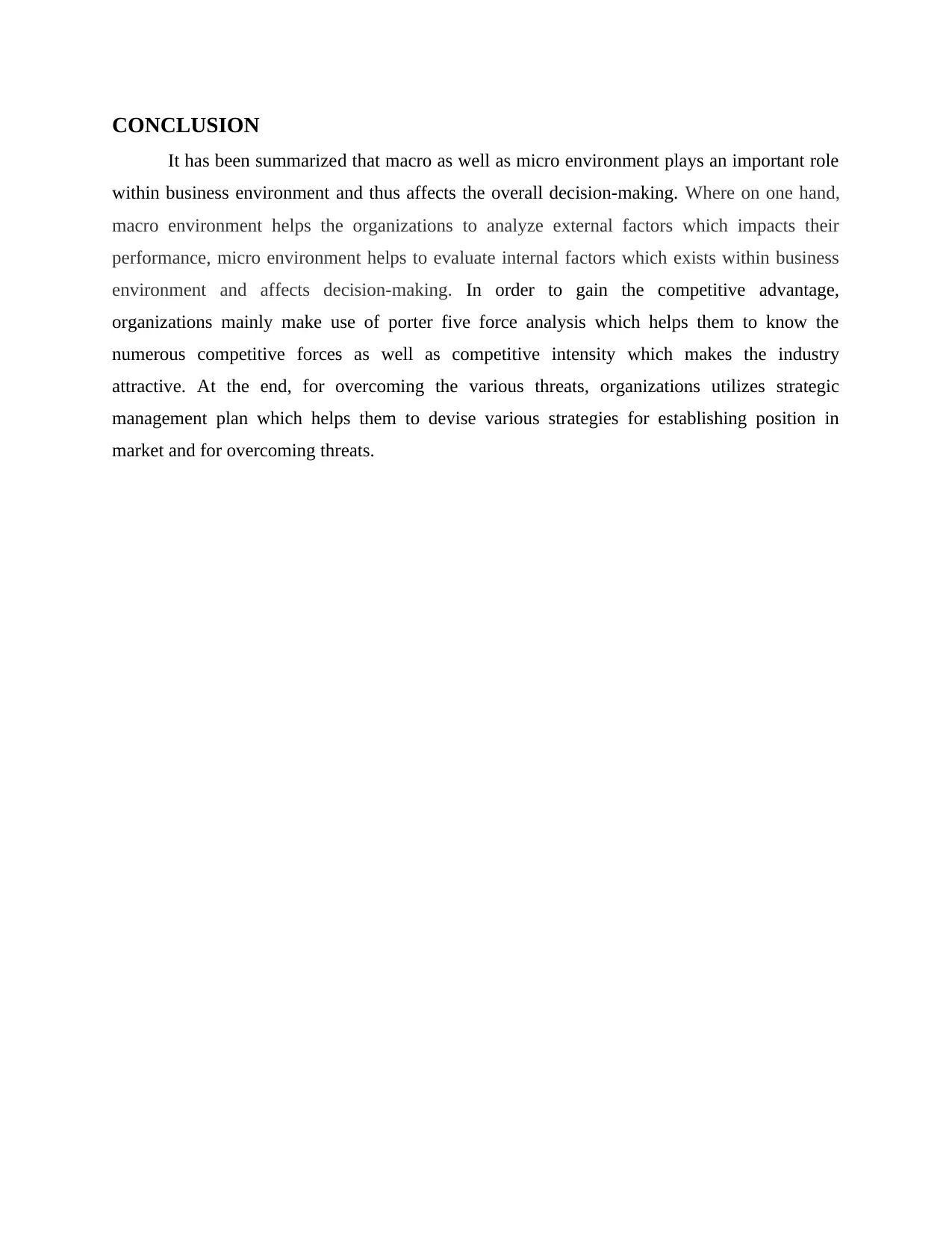
CONCLUSION
It has been summarized that macro as well as micro environment plays an important role
within business environment and thus affects the overall decision-making. Where on one hand,
macro environment helps the organizations to analyze external factors which impacts their
performance, micro environment helps to evaluate internal factors which exists within business
environment and affects decision-making. In order to gain the competitive advantage,
organizations mainly make use of porter five force analysis which helps them to know the
numerous competitive forces as well as competitive intensity which makes the industry
attractive. At the end, for overcoming the various threats, organizations utilizes strategic
management plan which helps them to devise various strategies for establishing position in
market and for overcoming threats.
It has been summarized that macro as well as micro environment plays an important role
within business environment and thus affects the overall decision-making. Where on one hand,
macro environment helps the organizations to analyze external factors which impacts their
performance, micro environment helps to evaluate internal factors which exists within business
environment and affects decision-making. In order to gain the competitive advantage,
organizations mainly make use of porter five force analysis which helps them to know the
numerous competitive forces as well as competitive intensity which makes the industry
attractive. At the end, for overcoming the various threats, organizations utilizes strategic
management plan which helps them to devise various strategies for establishing position in
market and for overcoming threats.


REFERENCES
Books & Journals
Amoako, G.K. and Dartey-Baah, K., 2020. Corporate Social Responsibility: Strategy for
Boosting Brand Perception and Competitive Advantage. In CSR and Socially
Responsible Investing Strategies in Transitioning and Emerging Economies (pp. 65-78).
IGI Global.
Ardley, B. and McIntosh, E., 2019. Business strategy and business environment: The impact of
virtual communities on value creation. Strategic Change.28(5). pp.325-331.
Braun, M., Latham, S. and Cannatelli, B., 2019. Strategy and business models: why winning
companies need both. Journal of Business Strategy.
Brewster, C., 2017. The integration of human resource management and corporate strategy. In
Policy and practice in European human resource management (pp. 22-35). Routledge.
Ghobadian, A. and Hopkins, M., 2017. How is traditional business strategy linked to CSR?. In
CSR and Sustainability (pp. 420-430). Routledge.
Goode, S. and Negoro, T., 2018. Can Competitive Strategy and Open Business Strategy
Coexist?.
Lehmann, C.F., 2016. Strategy and business process management: Techniques for improving
execution, adaptability, and consistency. Auerbach Publications.
Lozano, R., 2018. Sustainable business models: Providing a more holistic perspective. Business
Strategy and the Environment.27(8). pp.1159-1166.
Mohelska, H. and Sokolova, M., 2016. Smart, connected products change a company’s business
strategy orientation. Applied economics.48(47). pp.4502-4509.
Morelli, C.J., 2018. Business Strategy, Economic Crisis and the Theory of the Firm. In Post-
Crash Economics (pp. 47-67). Palgrave Macmillan, Cham.
Nayak, B., Bhattacharyya, S.S. and Krishnamoorthy, B., 2019. Integrating wearable technology
products and big data analytics in business strategy. Journal of Systems and Information
Technology.
Pramanik, P., Maiti, M.K. and Maiti, M., 2018. An appropriate business strategy for a sale item.
Opsearch.55(1). pp.85-106.
Raghunath, S. and Rose, E.L. eds., 2016. International Business Strategy: Perspectives on
Implementation in Emerging Markets. Springer.
Remane, G and et.al.,2017. Discovering digital business models in traditional industries. Journal
of Business Strategy.
Sanaei, M.R. and Sobhani, F.M., 2018. Information technology and e-business marketing
strategy. Information Technology and Management.19(3). pp.185-196.
Schaltegger, S., Hansen, E.G. and Lüdeke-Freund, F., 2016. Business models for sustainability:
Origins, present research, and future avenues.
Trevisan, E., 2016. The Irrational Consumer: Applying Behavioural Economics to Your Business
Strategy. Routledge.
Books & Journals
Amoako, G.K. and Dartey-Baah, K., 2020. Corporate Social Responsibility: Strategy for
Boosting Brand Perception and Competitive Advantage. In CSR and Socially
Responsible Investing Strategies in Transitioning and Emerging Economies (pp. 65-78).
IGI Global.
Ardley, B. and McIntosh, E., 2019. Business strategy and business environment: The impact of
virtual communities on value creation. Strategic Change.28(5). pp.325-331.
Braun, M., Latham, S. and Cannatelli, B., 2019. Strategy and business models: why winning
companies need both. Journal of Business Strategy.
Brewster, C., 2017. The integration of human resource management and corporate strategy. In
Policy and practice in European human resource management (pp. 22-35). Routledge.
Ghobadian, A. and Hopkins, M., 2017. How is traditional business strategy linked to CSR?. In
CSR and Sustainability (pp. 420-430). Routledge.
Goode, S. and Negoro, T., 2018. Can Competitive Strategy and Open Business Strategy
Coexist?.
Lehmann, C.F., 2016. Strategy and business process management: Techniques for improving
execution, adaptability, and consistency. Auerbach Publications.
Lozano, R., 2018. Sustainable business models: Providing a more holistic perspective. Business
Strategy and the Environment.27(8). pp.1159-1166.
Mohelska, H. and Sokolova, M., 2016. Smart, connected products change a company’s business
strategy orientation. Applied economics.48(47). pp.4502-4509.
Morelli, C.J., 2018. Business Strategy, Economic Crisis and the Theory of the Firm. In Post-
Crash Economics (pp. 47-67). Palgrave Macmillan, Cham.
Nayak, B., Bhattacharyya, S.S. and Krishnamoorthy, B., 2019. Integrating wearable technology
products and big data analytics in business strategy. Journal of Systems and Information
Technology.
Pramanik, P., Maiti, M.K. and Maiti, M., 2018. An appropriate business strategy for a sale item.
Opsearch.55(1). pp.85-106.
Raghunath, S. and Rose, E.L. eds., 2016. International Business Strategy: Perspectives on
Implementation in Emerging Markets. Springer.
Remane, G and et.al.,2017. Discovering digital business models in traditional industries. Journal
of Business Strategy.
Sanaei, M.R. and Sobhani, F.M., 2018. Information technology and e-business marketing
strategy. Information Technology and Management.19(3). pp.185-196.
Schaltegger, S., Hansen, E.G. and Lüdeke-Freund, F., 2016. Business models for sustainability:
Origins, present research, and future avenues.
Trevisan, E., 2016. The Irrational Consumer: Applying Behavioural Economics to Your Business
Strategy. Routledge.
Secure Best Marks with AI Grader
Need help grading? Try our AI Grader for instant feedback on your assignments.


1 out of 21
![[object Object]](/_next/static/media/star-bottom.7253800d.svg)





